Liquid crystalline coatings loaded with colistin for preventing development of biofilms on orthopedic implants
IF 9.4
1区 化学
Q1 CHEMISTRY, PHYSICAL
引用次数: 0
Abstract
The current antibacterial strategies focus on antibiotic therapy and extensive hygienic measures during orthopedic surgery. However, potential development of implant-associated infections remains a persistent clinical challenge. There is, therefore, a growing interest in introducing innovative safe antibacterial strategies for preventing and combating biofilm development on implants. Antibacterial coatings, particularly, are attractive for local delivery of antibacterial agents. We aim in this proof-of-concept study at introducing a novel and translatable implant coating approach, focusing on directed assembly of inverse non-lamellar lyotropic liquid crystalline (LLC) nanostructures on implants for prevention of initial bacterial attachment and biofilm formation through local delivery of the widely used cationic antibiotic colistin (COL). On exposure of dry lipid films deposited on model implants to aqueous solutions of COL prepared at different COL concentrations, a set of LLC coatings based on a commercial distilled monoglyceride product (or glycerol monooleate) were produced. In addition to small-angle X-ray scattering (SAXS) characterization investigations, in vitro studies were conducted for evaluating the antibacterial and antibiofilm properties of the LLC coatings against the Gram-negative bacteria Pseudomonas aeruginosa. The SAXS analysis indicated that all samples are inverse bicontinuous cubic Pn3m phases. Significant COL’s antibacterial activity and efficient protection against bacterial adhesion were demonstrated on coating model implants with LLC surface films produced by using aqueous solutions containing COL at concentrations of 50 and 500 µg/mL. On exposure to serum, the detected structural alterations and changes in COL’s antibacterial activity are also discussed. This study also highlights the implications of LLC self-assemblies for designing nanostructural coatings on orthopedic implants, which can prevent implant-associated biofilm infections through local delivery of antibacterial agents.

求助全文
约1分钟内获得全文
求助全文
来源期刊
CiteScore
16.10
自引率
7.10%
发文量
2568
审稿时长
2 months
期刊介绍:
The Journal of Colloid and Interface Science publishes original research findings on the fundamental principles of colloid and interface science, as well as innovative applications in various fields. The criteria for publication include impact, quality, novelty, and originality.
Emphasis:
The journal emphasizes fundamental scientific innovation within the following categories:
A.Colloidal Materials and Nanomaterials
B.Soft Colloidal and Self-Assembly Systems
C.Adsorption, Catalysis, and Electrochemistry
D.Interfacial Processes, Capillarity, and Wetting
E.Biomaterials and Nanomedicine
F.Energy Conversion and Storage, and Environmental Technologies

 求助内容:
求助内容: 应助结果提醒方式:
应助结果提醒方式:


